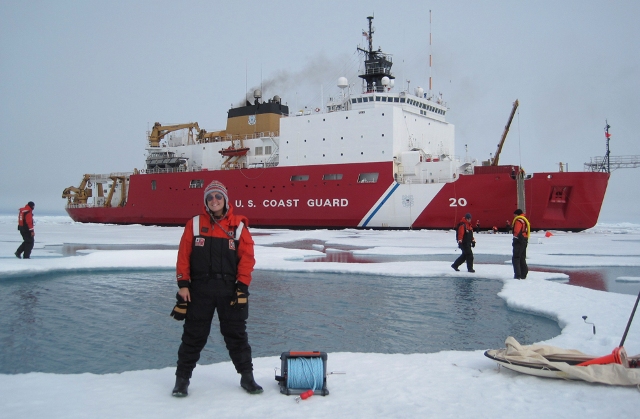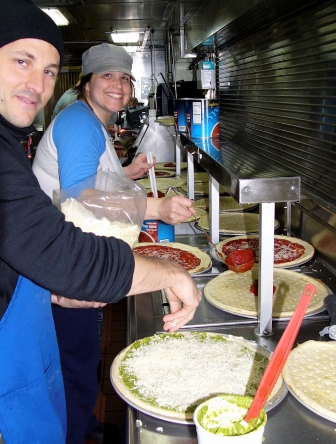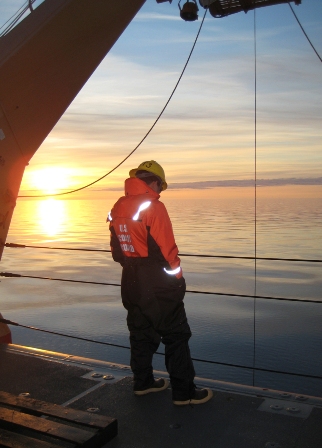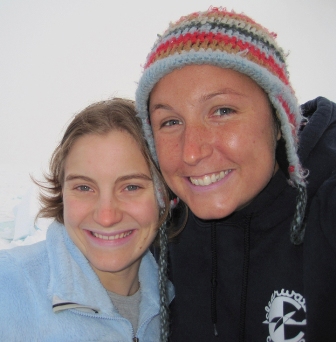From: Molly Palmer, Stanford University

Stanford Ph.D. student and blog author Molly Palmer working on the ice July 11. (Photo by Christie Wood)
Thursday 8 p.m.
Our team has been filtering seawater for almost 36 hours straight, but there are a lot of tired eyes today and it isn’t just the scientists. We’re fortunate to have such an accommodating and proficient coast guard crew – everyone I have met, from the mess cooks to the engineers to the officers who stand watch in the bridge, have exuded nothing but the most professional and helpful of attitudes, and they’ve been working incredibly hard to make sure our time on the Healy is as safe and successful as it can be. We tried to give back a little last week by cooking the Saturday evening “Morale” dinner, allowing the cooks to have a night off, but it feels like little compared to all they do for us. FS3 Tysin Alley helped us navigate the hectic world of cooking for 130+ people. I’m impressed with the culinary creativity that comes out of the science party – we end up with 35 different pizzas, from seafood to pesto vegetable to ‘meat extreme’ (extra bacon included). Cedric turns out to be a life-saver with his practiced chopping skills and pizza-making expertise – I should have known, he is French afterall. Our lab manager, Gert, also comes through big time by helping organize the pizza-making chain, and Melissa finishes the dessert station before I even realize she has started working on it. I also have a confession: most of the food was pre-made, including the pizza dough. So don’t start thinking we have a lot of free time on our hands.
Friday 5 p.m.
I have been especially impressed with the team of “Marine Science Technicians,” or MST’s, whose duty on board is to help our research go as smoothly as possible – as MST2 Owen Dicks told me on one of the first days, our mission is their mission, and they certainly have lived up to that standard. The MST team has been a godsend, helping us build strange contraptions for safely securing our science gear, pump out water-logged labs, creatively repair old/abused equipment, etc. I am not entirely sure what we would do without them and can’t thank them enough for all their efforts, particularly for the interest they show in our research and the countless jams they have helped us out of. The other day I watched MST3 Marshal Chaidez calmly handle what could have been a very bad and expensive situation as a large floe of thick multi-year ice appeared out of nowhere making a beeline straight for our science equipment. He fended it off with what appeared to be basically a long thin metal pole – keeping it away long enough for us to get our gear out of the water. Not that I’m complaining – sometimes the simplest solutions are the best.
Saturday 7 p.m.
We’ve just had a delicious “Morale dinner” of chili – warm bellies lead to happy scientists and crew alike. It’s been below freezing for most of the week and I certainly have been a bit chilled at times – this meal has been a perfect antidote. My roommate Kate and I are preparing for an easy night in the lab, with just a few hours of sampling to do and potentially some “free time” where we might even get to watch the 8pm movie being shown in the helicopter hangar – popcorn and soda included. The mood is light and everyone seems pretty relaxed – it seems “Morale Night” has been successful afterall. We shuffle back to lab with smiles on our faces and head towards our work bench where we see our team gathered. Surprise: we’re going to start a new transect line which we’ll be sampling every hour or so for the next 3 days straight. Scratch ‘movie in the hangar’ off our list of evening activities, to be replaced with hours of filtering and experimenting. Kate and I sneak up and grab some popcorn and cans of soda anyway – it’s going to be a long night and the refreshments will come in handy.
Monday 1 p.m.
My alarm has been going off for half an hour before I finally am able to open one eye. This feels like a big accomplishment and I silently congratulate myself. It is the small things, when you’re seasick and have hours of work ahead of you. I visualize for several minutes moving my legs and eventually manage to get them over the side of the bed. Or at least I think I do. At some point later, I wake up again and realize I am going to be late if I don’t get a move on soon – my more-punctual roommate Kate is already showered and dressed. I pop some more Meclizine and roll out of bed; life at sea – always interesting to say the least.
Tuesday 10 a.m.
It isn’t just the MST’s who make our work easier – for example, there is an entire team of engineers working below decks who we don’t see very often but keep the ship running. They walk through the main lab making rounds to check safety every hour or so, easily distinguishable by the faint scent of diesel and the enormous earmuffs they wear for hearing protection. I was lucky enough to tag along on one of these rounds with ET2 Jeremy Gainey a week or so ago. It’s quite an adventure to travel through the bowels of such a huge ship as this – I felt like I was exploring some lost world, with deep underground steel caves and vast forests of metal pipes. I couldn’t believe all the stuff Jeremy knew about each and every valve, room, pipe, and piece of machinery – and I thought I was the nerd!
Wednesday 8 p.m.
A quick fake to the left and I double back towards the board and get an easy backdoor-cut layup – my teammates Zach and Kevin are excellent passers and I haven’t totally lost my athletic ability even after over a month at sea. Of course, “quick” is relative when you’re playing 3 vs. 3 basketball on a moving icebreaker after nearly 24 hours of sampling but I am glad to be moving around. I chuckle at the next team we play – the group from Scripps composed of both the Brian’s and Elliot. They are all dressed alike in board shorts and t-shirts and exude Southern California surfer style like nothing I have seen in weeks. All we need is a little sunscreen scent and some flippy floppies and we could be in San Diego. Oh, and some warm weather.
Thursday 1 p.m.
Standing at my main science station, I am only half paying attention to what I’m doing – mostly I am eavesdropping on a conversation about ring sizes and caterers that is happening behind me to my left. Two of Karen’s students, Luke and Christie, are both getting married soon after getting off the ship and have wedding plans to make. For me, it’s easy to forget sometimes about the world that exists outside the ship, but I suppose if I had a fiancé waiting for me back home I’d probably be a little more attentive to my email (sorry mom and dad). It’s nice to hear talk about “real life” sorts of things though, like weddings and past trips and families – I can’t be focused on science 100% of the time or I’d go crazy.
Thursday 9 p.m.
We’re so swamped with stations we can barely keep up. I con Sharmila into helping me label vials to prep for the next CTD and madly rush to get everything ready – I’m bringing my A-game today and it is definitely necessary. I smell freshly ground coffee beans and my entire face lights up; I follow the scent to find Scott and Susan, who have enough sea-going experience to make up several lifetimes and know that nothing picks up morale like a fresh pot of coffee. A friendly smile and nice words go far towards getting us all through these crazy days and I am thankful for the positive attitudes of most of my colleagues. Everyone knows how important it is to do the best job we can despite all the difficulties of being at sea, and how critical this project is. One of the goals of my research for the Icescape cruise is to understanding the various patterns of biological productivity in the Arctic – this field research will complement the numerical model I have been working on to simulate carbon dynamics in the region, and I feel fortunate for the opportunity to get out and actually observe the area I am attempting to model.
Friday 5 a.m.
It is the middle of July and it is snowing – not the usual summer experience for me to say the least. Outside the world is a frozen grey canvas of ridged meter-thick ice and thousands of rippled little melt ponds that reflect the soft blue-grey haze of a sky. It isn’t always this pale dull color palette in the Arctic but it makes the bright red of the USCGC Healy stand out even more than usual. I like to wander the open decks at night when I get off shift sometime after 3am – this is when the sun gets lowest on the horizon (it never sets this far north) and the light often makes the entire deck glow a firey orange red, although not today in this cloudy stagnant iceworld. It is easy to forget you’re on an important scientific mission when you’re surrounded by such beauty and I silently send my thanks once again for such an incredible opportunity to be part of the NASA ICESCAPE mission.

Researchers Cedric Fichot and Kristen Shake prepare pizzas during the “Science Morale Dinner” in the mess deck galley. (Photo by Jim Swift)

MST3 Marshal Chaidez operates the CTD in the calm waters of the early morning. (Photo by Brian Seegers)

Stanford researchers Kate Lowry (left) and Molly Palmer catch a breath of fresh air in the frozen iceworld outside the USCGC Healy after a long day in the lab. (Photo by Molly Palmer)

The focsle glows firey orange-red in the early morning light. (Photo by Molly Palmer)

Algae omelett tastes very nice at all !
Let me guess, you took that picture with Kate because you both used that white “chappy”, didn’t you?